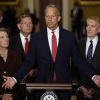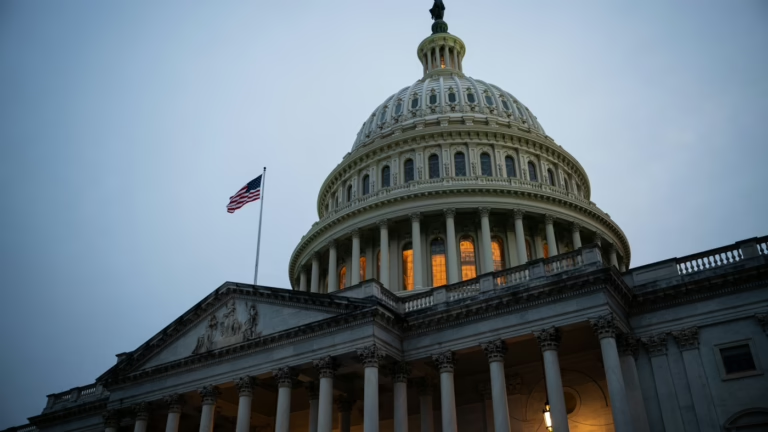The U.S. Capitol on Tuesday as the government moved closer to a shutdown.
Graeme Sloan/Bloomberg via Getty Images
hide caption
toggle caption
Graeme Sloan/Bloomberg via Getty Images
The federal government has largely ceased operations following the Senate’s inability to pass competing funding proposals from Republicans and Democrats aimed at preventing a shutdown.
Republicans blocked a Democratic bill that would have funded the government through the end of October and extended federal healthcare subsidies set to expire by year’s end. Conversely, Democrats rejected a short-term funding plan passed by the House, which would have maintained current spending levels until November 21. Both bills required a 60-vote supermajority to advance but failed to secure it.
Democrats have maintained that they will not support any spending legislation unless Republicans agree to prolong the Affordable Care Act insurance subsidies. This condition was not met, leading to the stalemate.
Following the unsuccessful votes, Russell Vought, Director of the Office of Management and Budget, directed federal agencies to begin orderly shutdown procedures.
The full extent and duration of the shutdown’s effects remain uncertain. Essential programs such as Social Security, Veterans Affairs benefits, and Medicare and Medicaid payments will continue, though recipients may experience delays.

Federal employees deemed nonessential will face the brunt of the shutdown’s consequences, with many experiencing work stoppages and unpaid furloughs.
The Congressional Budget Office projects that approximately 750,000 federal workers could be furloughed each day during the shutdown.
President Donald Trump hinted at potential drastic measures during the shutdown, including large-scale federal workforce reductions and program eliminations.
“During the shutdown, we have the ability to make changes that are permanent and unfavorable to them,” Trump stated in the Oval Office. “We can reduce staff significantly. While we prefer not to, we must address fraud, waste, and abuse.”
Some shutdown effects will be immediate, while others may emerge if the impasse continues:
- Many federal employees and active military personnel could miss paychecks starting mid-October.
- Although air traffic controllers and TSA agents are classified as essential, past shutdowns saw some call in sick rather than work without pay.
- The Women, Infants, and Children (WIC) nutrition program may soon exhaust its funding.
- The status of National Parks remains uncertain; during previous shutdowns, parks stayed open but operated without staff.
Partisan Standoff Intensifies as Deadline Approaches
As the funding deadline loomed, tensions escalated with both parties blaming each other for the shutdown.
Democrats argue their stance protects Americans’ healthcare by advocating for the extension of insurance subsidies and opposing recent GOP-driven cuts to healthcare programs enacted in the summer’s tax and spending legislation.
“Republicans are forcing America into a shutdown by rejecting bipartisan negotiations and pushing a partisan agenda that threatens healthcare,” said Minority Leader Chuck Schumer on Tuesday evening.

Meanwhile, Republicans accuse Democrats of leveraging the budget process to push partisan priorities.
“Senate Democrats have put their political agenda ahead of the American people,” stated Majority Leader John Thune just before the shutdown took effect.
Uncertainty Looms Over Shutdown Duration
Republican leaders intend to keep voting on their temporary funding proposal, hoping to attract more Democratic support as the shutdown continues.
“In our previous vote before recess, only one Democrat supported our plan. Tonight, three did. The divide is starting to show,” said Republican Whip John Barrasso.
Senators John Fetterman (D-PA), Catherine Cortez-Masto (D-NV), and independent Angus King (ME), who caucuses with Democrats, voted in favor of the Republican bill on Tuesday.

“A bipartisan resolution is essential to prevent a looming healthcare crisis, but we cannot resolve this by shifting hardship from one group to another,” Cortez-Masto emphasized.
However, six Democrats who supported a similar continuing resolution in March withheld their support this time. Both Schumer and Thune anticipate that some lawmakers may eventually reconsider their positions.
Senator Rand Paul (R-KY) was the sole Republican opposing the measure on Tuesday.
The previous government shutdown, spanning December 2018 to January 2019, lasted 35 days, marking the longest in U.S. history.
With both parties entrenched and unwilling to compromise, the timeline for ending the shutdown remains uncertain.



















